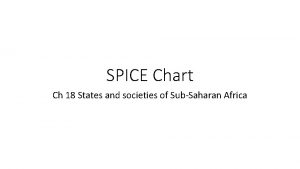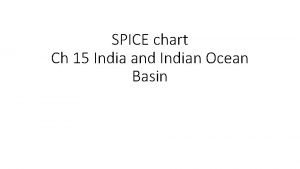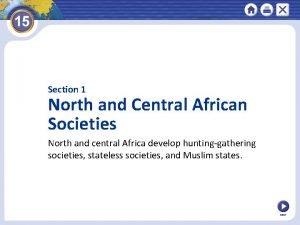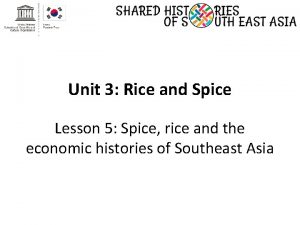SPICE Chart Ch 18 States and societies of









- Slides: 9

SPICE Chart Ch 18 States and societies of Sub-Saharan Africa

Social • Most African states had a kin-based society • Village council took care of everyday issues, a chief from the council would lead affairs and settle disputes • Some societies grew into kingdoms, empires and city-states • No private property, typical gender roles (men with heavy labor, women domestic chores) • Women did have other positions like merchants and often had higher authority than other post-classical regions • Age-set jobs, formed tight bonds with people

Political Smaller regions based on family ties but regions grew West Africa (sub-Sahara)- Ghana, Mali, Songhay Kingdom of Congo near rainforest Axum in Ethiopia Big cities- Timbuktu, Kilwa , Great Zimbabwe Sundiata founded Mali, Mansa Musa promoted Islam and trade through his pilgrimage to Mecca • Some powerful chiefs overrode kinship networks and imposed authority with military back up (Ife and Benin) • • •


Interaction with Environment Bantu migrations from 2000 BCE-1000 CE Agriculture and herding spread with the migration Iron smelting increased metallurgy and tools Gold in sub-Saharan regions led to prosperity Gold traded for salt found in slabs in the Sahara People needed to adapt to geographic regions (rainforest, savanna, desert) • Camels quicken communication and trade across the desert after 300 CE • • •

Culture Bantu language was foundation for tracking migrations, the east coast language became known as Swahili (Arab word for coast) Religion based on tradition of animism- spirits often associated with natural elements, ancestor- veneration and rituals (blended with Islam and Christianity later) Islam spread as merchants crossed the Sahara- many rulers converted to increase diplomacy with trade In Ethiopia- Christianity was dominant (stayed from Roman Empire days), kings believed they were descendants of King Solomon Many villages traced their roots through a common ancestor (lineage) and some were matrilineal

The Larabanga Mosque, one of Ghana's oldest mosques

Economics • Once camels replaced horses, trans-Saharan merchants linked the West African kingdoms and gold-salt trade prospered • East coast port cities linked Indian Ocean trade • Slave trade had been in place before being used in the colonies, most were captives of war or criminals and worked in agricultural labor • Demand from slaves grew from Eastern Europe and Middle east, sometimes slave raids happened against smaller villages


















